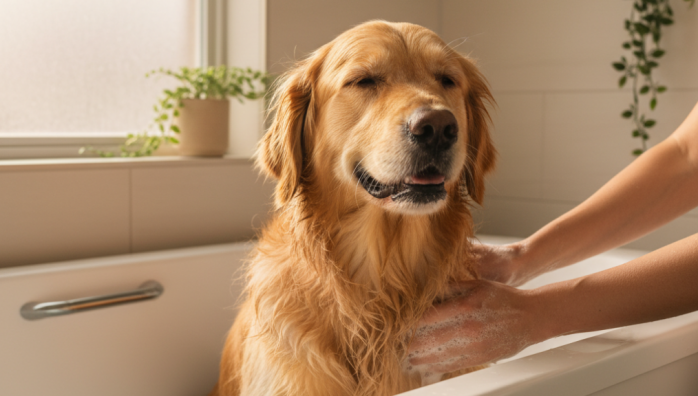Bathing Your Dog At Home Safely
by admin in Pet Care Basics 21 - Last Update November 24, 2025

I\'ll be honest, for years, bath time in my house was pure chaos. It involved a soaking wet bathroom, a stressed-out dog, and an equally stressed-out me. I thought it was just something I had to endure. But after years of trial and error with my own dogs, I\'ve learned that it doesn\'t have to be a battle. With the right preparation and a calm approach, bathing your dog at home can actually be a positive, bonding experience. I want to share the simple, practical steps I\'ve discovered that completely changed the game for us.
Getting prepared: the key to a stress-free bath
The biggest mistake I used to make was trying to wrangle my dog into the tub unprepared. Everything changed when I started treating it like a project and getting all my tools ready first. This simple shift in mindset prevents you from having to leave a wet, anxious dog unattended while you grab a forgotten towel.
First, choose your battle station
Whether it\'s your bathtub, a walk-in shower, or a dedicated dog tub in the laundry room, make it a safe space. The most important thing I ever added was a non-slip mat. Dogs panic when they can\'t get a secure footing, and that mat was an instant game-changer for my nervous pup. Make sure the area is clear of anything you don\'t want to get wet or knocked over.
Next, gather your supplies
Having everything within arm\'s reach is non-negotiable. It keeps you focused on your dog and reassures them with your presence. Here’s my go-to checklist:
- Dog-Specific Shampoo: Human shampoos have the wrong pH balance and can severely irritate a dog\'s skin. I learned this the hard way. If your dog has sensitive skin, a vet-approved oatmeal or hypoallergenic formula is a great choice.
- Lots of Towels: You\'ll need at least two. One for the initial dry-off in the tub, and a second, drier one for the floor or wherever you\'ll finish up.
- A Non-Slip Mat: I mentioned it before, but it\'s so important I\'m saying it again!
- Treats: High-value treats are your best friend for creating a positive association with the bath.
- A Cup or Handheld Sprayer: This gives you much better control over where the water goes, especially for rinsing.
The bathing process, step-by-step
Once you\'re all set up, it\'s time for the main event. Remember to stay calm and use a soothing voice. Your dog will pick up on your energy.
- Brush First, Bathe Second: Always give your dog a thorough brush-out before they get wet. Water tightens mats and tangles, making them almost impossible to remove. Brushing first removes loose fur and makes washing much more effective.
- Check the Water Temperature: This is crucial for safety and comfort. Test the water on your own wrist, just like you would for a baby. It should be lukewarm—not too hot, not too cold.
- Wet from the Neck Down: Using your sprayer or cup, gently wet your dog\'s body, avoiding their head and ears. Getting water in their ears can lead to infections, and most dogs dislike water being poured on their face.
- Lather Up: Apply a line of shampoo down their back and work it into a gentle lather. Work your way down their legs and to their tail. I always use this time to give a little massage, turning it into a pleasant experience.
- Rinse, Rinse, and Rinse Again: This is where I see many people make a mistake. Leftover shampoo residue is a leading cause of skin irritation and itchiness after a bath. Rinse until the water runs completely clear and you can no longer feel any slippery soap on their coat.
The post-bath routine
You\'re almost there! The moments after the bath are just as important.
First, give your dog a quick squeeze-out and towel dry while they\'re still in the tub to minimize shaking. Then, lead them to a towel-covered floor for a more thorough drying. Many dogs get the \'zoomies\' after a bath—it\'s totally normal! Let them run it out in a safe, contained area. Finally, end the entire experience with lots of praise and a special treat. This reinforces that bath time is a positive event with a great reward at the end.
A note on skin issues
While these tips have worked wonders for my own dogs, every animal is different. If you notice persistent itching, redness, or any other skin problems, it\'s not just a grooming issue. That\'s a sign that it\'s time to check in with your veterinarian. What works for one dog might not be right for another, and a professional can help you get to the root of any underlying health concerns.














